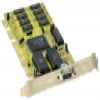Windows 3.0 is the third major release of Microsoft Windows, and came out on May 22 1990. It became the first widely successful version of Windows (see history of Microsoft Windows) and a powerful rival to Apple Macintosh and the Commodore Amiga on the GUI front. It was succeeded by Windows 3.1.
Windows 3.0 succeeded Windows 2.1x and included a significantly revamped user interface as well as technical improvements to make better use of the memory management capabilities of Intel's 80286 and 80386 processors. Text-mode programs written for MS-DOS could be run within a window (a feature previously available in a more limited form with Windows/386 2.1), making the system usable as a crude multitasking base for legacy programs. However, this was of limited use for the home market, where most games and entertainment programs continued to require raw DOS access.
The MS-DOS Executive file manager/program launcher was replaced with the icon-based Program Manager and the list-based File Manager, thereby simplifying the launching of applications. The MS-DOS Executive is also included as an alternative to these. The Control Panel, previously available as a standard-looking applet, was re-modeled after the one in Mac OS. It centralized system settings, including limited control over the color scheme of the interface. A number of simple applications were included, such as the text editor Notepad and the word processor Write (both inherited from earlier versions of Windows), a macro recorder (new; later dropped), and a calculator (also inherited). The earlier Reversi game was complemented with a card game named Solitaire.
Windows 3.0 was the last version of Windows to advertise 100% compatibility with older Windows applications. This only applies to real mode.
Interface
Windows 3.0 included a more user friendly interface and did include the MS-DOS Executive with the File Manager. It was weird enough that it had two file managers and Program Manager. It included Solitaire as a additional game with Reversi. Paint (renamed Paintbrush) allowed the user to draw in color and create bitmap and PCX images. It included support for VGA Monitors. Icons were given color treatment which provided an even more user friendly interface. Unlike Windows 1.0 and 2.0, the user could change the system configuration (mouse, display, network adapter).
Windows 3.0 with VGA Support included improved color support. Control Panel was improved with all main controls in icons. Windows Setup was located in the Main program Group. Program Manager allowed the users as well as program to create program groups making commonly used programs easy to find without knowing the programs real file name (PROGRAM.EXE).
The official system requirements for Windows 3.0:
- 8086/8088 processor or better
- 640K conventional memory
- a hard disk with 6-7MB of free space
- CGA/EGA/VGA/Hercules/8514/a graphics and an appropriate and compatible monitor
Also, a Microsoft-compatible mouse is recommended.
Memory modes
Windows 3.0 was the only version of Windows that could be run in three different memory modes:
- Real mode, intended for older computers with a CPU below Intel 80286, and corresponding to its real mode;
- Standard mode, intended for computers with an 80286 processor, and corresponding to its protected mode;
- 386 Enhanced mode, intended for newer computers with an Intel 80386 processor or above, and corresponding to its protected mode and virtual 8086 mode.
Real mode primarily existed as a way to run Windows 2.x applications. It was removed in Windows 3.1x. Almost all applications designed for Windows 3.0 had to be run in Standard or 386 Enhanced modes. However, it was necessary to load Windows 3.0 in Real mode to run SWAPFILE.EXE, which allowed users to change virtual memory settings.
Standard mode was used most often as its requirements were more in-line with an average PC of that era – a 286 processor with at least 1MB of memory. Incidentally, not all 286 and 386 computers remapped memory between 640 KB (the upper limit of Conventional memory) and 1 MB as extended memory — some did not show memory between 640 KB and 1 MB at all — so on some systems with 1 MB of RAM, there is no extended memory and memory was limited to 640 KB. On such a system, Windows was limited to real mode. Many 386 computers ran Windows 3.0 in Standard mode due to a lack of memory.
386 Enhanced mode implemented all the benefits of Standard mode, plus 32-bit addressing and paging for faster memory access, and virtual 8086 mode for safer execution of MS-DOS programs: each of them now ran in a virtual machine. In the previous modes, multiple MS-DOS programs could only be run in full-screen, and only the program currently active was executing; but in 386 enhanced mode, they could be run simultaneously in separate windows. This mode required a 386 processor and 1MB of extended memory (in addition to the base 640KB) – beyond the specifications of most PCs sold in 1990.
The Multimedia Extensions
The Multimedia Extensions were released in autumn 1991 to support sound cards, as well as CD-ROM drives, which were then becoming increasingly available. The Multimedia Extensions were released to Original Equipment Manufacturers (OEMs), mainly CD-ROM drive and sound card manufacturers, and added basic multimedia support for audio input and output and a CD audio player application to Windows 3.0. The Multimedia Extensions' new features were not available in Windows 3.0 real mode. Windows 3.1x would later incorporate many of its features.
Microsoft developed a Windows Sound System to complement these extensions.

